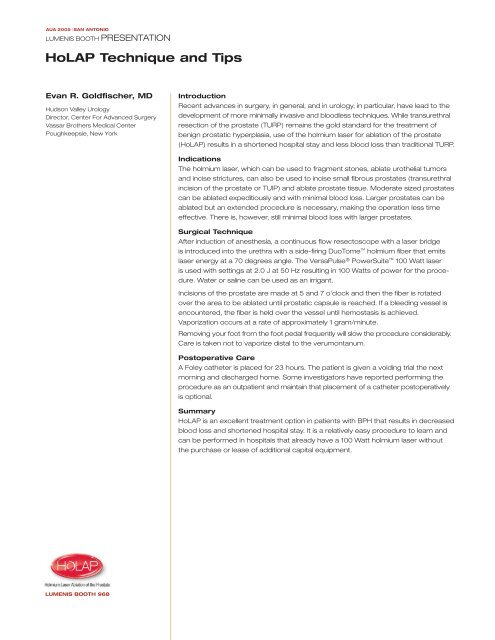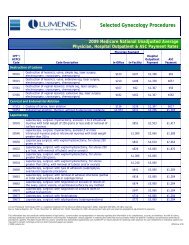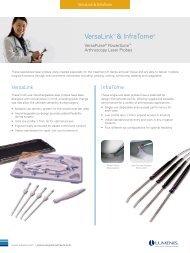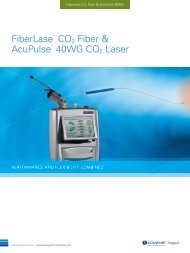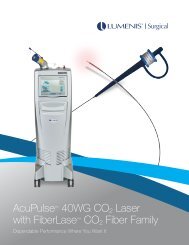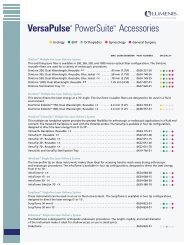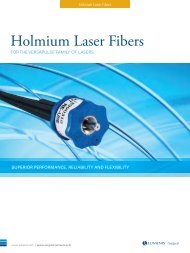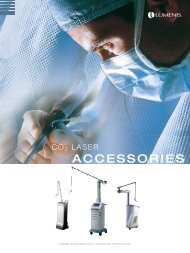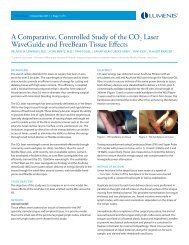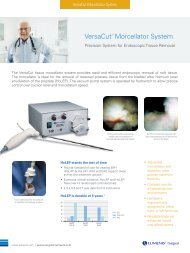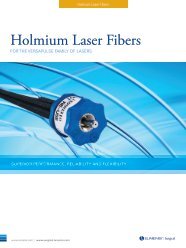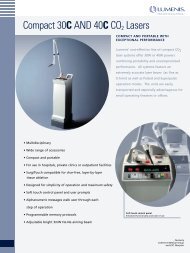HoLAP Technique and Tips - Lumenis Surgical
HoLAP Technique and Tips - Lumenis Surgical
HoLAP Technique and Tips - Lumenis Surgical
Create successful ePaper yourself
Turn your PDF publications into a flip-book with our unique Google optimized e-Paper software.
AUA 2005 | SAN ANTONIO<br />
LUMENIS BOOTH PRESENTATION<br />
<strong>HoLAP</strong> <strong>Technique</strong> <strong>and</strong> <strong>Tips</strong><br />
Evan R. Goldfischer, MD<br />
Hudson Valley Urology<br />
Director, Center For Advanced Surgery<br />
Vassar Brothers Medical Center<br />
Poughkeepsie, New York<br />
Introduction<br />
Recent advances in surgery, in general, <strong>and</strong> in urology, in particular, have lead to the<br />
development of more minimally invasive <strong>and</strong> bloodless techniques. While transurethral<br />
resection of the prostate (TURP) remains the gold st<strong>and</strong>ard for the treatment of<br />
benign prostatic hyperplasia, use of the holmium laser for ablation of the prostate<br />
(<strong>HoLAP</strong>) results in a shortened hospital stay <strong>and</strong> less blood loss than traditional TURP.<br />
Indications<br />
The holmium laser, which can be used to fragment stones, ablate urothelial tumors<br />
<strong>and</strong> incise strictures, can also be used to incise small fibrous prostates (transurethral<br />
incision of the prostate or TUIP) <strong>and</strong> ablate prostate tissue. Moderate sized prostates<br />
can be ablated expeditiously <strong>and</strong> with minimal blood loss. Larger prostates can be<br />
ablated but an extended procedure is necessary, making the operation less time<br />
effective. There is, however, still minimal blood loss with larger prostates.<br />
<strong>Surgical</strong> <strong>Technique</strong><br />
After induction of anesthesia, a continuous flow resectoscope with a laser bridge<br />
is introduced into the urethra with a side-firing DuoTome holmium fiber that emits<br />
laser energy at a 70 degrees angle. The VersaPulse ® PowerSuite 100 Watt laser<br />
is used with settings at 2.0 J at 50 Hz resulting in 100 Watts of power for the procedure.<br />
Water or saline can be used as an irrigant.<br />
Incisions of the prostate are made at 5 <strong>and</strong> 7 o'clock <strong>and</strong> then the fiber is rotated<br />
over the area to be ablated until prostatic capsule is reached. If a bleeding vessel is<br />
encountered, the fiber is held over the vessel until hemostasis is achieved.<br />
Vaporization occurs at a rate of approximately 1 gram/minute.<br />
Removing your foot from the foot pedal frequently will slow the procedure considerably.<br />
Care is taken not to vaporize distal to the verumontanum.<br />
Postoperative Care<br />
A Foley catheter is placed for 23 hours. The patient is given a voiding trial the next<br />
morning <strong>and</strong> discharged home. Some investigators have reported performing the<br />
procedure as an outpatient <strong>and</strong> maintain that placement of a catheter postoperatively<br />
is optional.<br />
Summary<br />
<strong>HoLAP</strong> is an excellent treatment option in patients with BPH that results in decreased<br />
blood loss <strong>and</strong> shortened hospital stay. It is a relatively easy procedure to learn <strong>and</strong><br />
can be performed in hospitals that already have a 100 Watt holmium laser without<br />
the purchase or lease of additional capital equipment.<br />
LUMENIS BOOTH 968
AUA 2005 | SAN ANTONIO<br />
LUMENIS BOOTH PRESENTATION<br />
<strong>HoLAP</strong> <strong>Technique</strong> <strong>and</strong> <strong>Tips</strong><br />
Surendra Kumar, MD<br />
Oakwood Annapolis Hospital<br />
Westl<strong>and</strong>, Michigan<br />
Introduction<br />
<strong>HoLAP</strong> represents a significant advance in the surgical treatment of patients with<br />
obstructive urinary symptoms caused by BPH. The availability of a powerful 100 Watt<br />
holmium laser has made it possible to efficiently vaporize any size prostate. Patients<br />
have no significant perioperative bleeding <strong>and</strong> experience excellent improvement in<br />
clinical symptoms.<br />
Equipment<br />
The 100 Watt <strong>Lumenis</strong> VersaPulse ® PowerSuite holmium laser with a DuoTome <br />
SideLite fiber is used as the laser energy source <strong>and</strong> delivery system. Laser settings<br />
are usually 2 J <strong>and</strong> 50 Hz.<br />
A 25 F or 27 F continuous flow resectoscope, preferably with a revolving laser bridge,<br />
is recommended. A fiber bridge big enough to accommodate the DuoTome fiber<br />
(7.2 F diameter) is used to stabilize the fiber during treatment.<br />
Procedure<br />
<strong>HoLAP</strong> can be done with spinal or general anesthesia. It is mostly performed as an<br />
outpatient procedure. Sterile water or normal saline is used for irrigation.<br />
The procedure is generally started at the vesicle neck by first vaporizing the median<br />
lobe if present. The laser tip is placed 1-2 mm from but not necessarily touching the<br />
tissue when the laser is activated.<br />
The endoscope is kept proximal from the verumontanum at all times while the laser<br />
is activated. Vaporization is performed by rotating the fiber <strong>and</strong> moving it back <strong>and</strong><br />
forth until circular fibers of the prostate capsule are visible. Lateral lobe vaporization<br />
starts at 5 o'clock position. A wide groove from 5 to 3 o'clock is extended by gently<br />
pulling the fiber distally as it is rotated sideways. Both the lateral lobes <strong>and</strong> anterior<br />
tissue followed by the base of the prostate are then vaporized.<br />
Apical tissue is vaporized at the end. Special care should be taken to not damage<br />
the proximal urethra. This is done by keeping the endoscope stationary <strong>and</strong> moving<br />
the fiber sideways, not back <strong>and</strong> forth. Intraoperative bleeding is minimal <strong>and</strong> the<br />
procedure is virtually bloodless.<br />
The procedure is complete when capsule fibers have been reached <strong>and</strong> an open<br />
prostatic cavity is present.<br />
Procedural <strong>Tips</strong><br />
• The fiber tip should be close to tissue to vaporize most efficiently.<br />
• To avoid damaging the telescope do not pull the fiber tip into the scope past the<br />
black circular marking.<br />
• The scope tip should always be positioned proximal to the verumontanum when<br />
the laser is activated to protect the membranous urethra.<br />
• Bleeding is controlled by moving the fiber tip 2-3 mm away from the bleeding<br />
vessel while activating the laser.<br />
Postoperative Care<br />
An 18 F Foley catheter is left indwelling at the end of the procedure. Patients are<br />
usually discharged without catheters within 24 hours. Antibiotics are prescribed for<br />
a week. Pain medications are generally not needed. Patients may resume normal<br />
activities in 2 to 3 weeks. Heavy exertion should be postponed for about a month.<br />
Conclusion<br />
The <strong>HoLAP</strong> procedure provides excellent improvement in clinical symptoms for<br />
patients with little perioperative bleeding <strong>and</strong> few if any complications.<br />
LUMENIS BOOTH 968
AUA 2005 | SAN ANTONIO<br />
LUMENIS BOOTH PRESENTATION<br />
<strong>HoLAP</strong> for Large Prostates<br />
Surendra Kumar, MD<br />
Oakwood Annapolis Hospital<br />
Westl<strong>and</strong>, Michigan<br />
Introduction<br />
The holmium laser optimal penetration of less than 0.5 mm <strong>and</strong> its remarkable<br />
hemostatic properties make it an ideal laser for treating BPH symptoms. With the<br />
availability of a 100 Watt laser, holmium has become efficient for vaporization of any<br />
size prostate, including those in excess of 100 cc that are generally treated with<br />
open prostatectomy.<br />
Early Results<br />
The mean prostate volume reduction was 56% following the procedure. This was<br />
a substantial reduction in prostate volume comparable to the amount removed with<br />
TURP. A summary table of early clinical experience using <strong>HoLAP</strong> for very large<br />
prostate gl<strong>and</strong>s is provided below.<br />
The mean prostate volume was reduced postoperatively from 143 cc to 63 cc.<br />
AUA symptom scores were reduced from 23.6 to 6.6. Maximum flow rates increased<br />
fourfold. No transfusions were required. Urethral catheters in all but 3 patients were<br />
removed before discharge. There were no intraoperative complications <strong>and</strong><br />
postoperative complications were infrequent.<br />
One patient had clot retention postoperatively at 4 weeks. Five patients had episodes<br />
of urinary retention that resolved in a few days when treated with catheterization <strong>and</strong><br />
bethanechol. All patients were voiding well at the 3- to 4-week follow-up.<br />
<strong>HoLAP</strong> vs GreenLight PVP<br />
The KTP laser in my experience of over 100 PVP cases does not come close to<br />
providing the level of success possible with the holmium laser, particularly with<br />
gl<strong>and</strong>s larger than 50 cc for several reasons.<br />
• The KTP laser, with its deeper tissue penetration, tends to leave more coagulated<br />
necrotic tissue behind resulting in prolonged postoperative symptoms.<br />
• The KTP fiber tip degradation with continuous use in larger gl<strong>and</strong>s can lead to deep<br />
coagulation without vaporization. Deep coagulation can result in dysuria, retention<br />
<strong>and</strong> delayed symptom relief.<br />
• During treatment of larger gl<strong>and</strong>s, the orange safety glasses used with KTP laser<br />
make the procedure very difficult to do in the presence of even slight bleeding.<br />
The clear glasses used with the holmium laser, however, allow the procedure to<br />
continue even if bleeding occurs.<br />
• The KTP laser needs special electrical <strong>and</strong> plumbing hook-ups in the operating<br />
room, thus limiting its use to these rooms.<br />
Conclusion<br />
The holmium laser is remarkably efficient for vaporizing prostate gl<strong>and</strong>s of any size,<br />
including those in excess of 100 cc.<br />
TABLE: Early clinical experience using <strong>HoLAP</strong> for very large prostates.<br />
<strong>HoLAP</strong> Results on 13 Patients with Large Prostate Gl<strong>and</strong>s<br />
Variable Preop. Postop.<br />
AUA Symptom Score 23.6 6.6<br />
Max Flow Rate 4.9 cc/sec 22.3 cc/sec<br />
Serum Sodium 137 136<br />
Hemoglobin 13.2 12.8<br />
Mean Prostate Vol. Preop. 143 cc (90-232)<br />
Mean Prostate Vol. Postop. 63 cc (35-115)<br />
Average Operating Time 95 min (46-203)<br />
Average Hospital Stay<br />
1.4 days<br />
LUMENIS BOOTH 968
AUA 2005 | SAN ANTONIO<br />
LUMENIS BOOTH PRESENTATION<br />
<strong>HoLAP</strong> <strong>Technique</strong> <strong>and</strong> <strong>Tips</strong><br />
Ramsay L. Kuo, MD<br />
Assistant Professor of Urology<br />
Thomas Jefferson University<br />
Medical Collage<br />
Philadelphia, PA<br />
Introduction<br />
The holmium laser is a versatile tool. The 100 Watt high-powered VersaPulse ®<br />
PowerSuite lasers can not only be utilized to fragment urinary calculi of any<br />
composition but also to efficiently ablate, or vaporize, obstructive prostate tissue<br />
with minimal blood loss.<br />
The <strong>HoLAP</strong> technique has a flat learning curve <strong>and</strong> can be incorporated very quickly<br />
into one's surgical practice. <strong>HoLAP</strong> outcomes are similar to those achieved by TURP.<br />
The minimal penetration depth of holmium energy minimizes postoperative irritative<br />
voiding symptoms, while the ability to use normal saline as the irrigant during treatment<br />
virtually eliminates the possibility of dilutional hyponatremia. Long-term follow-up of<br />
<strong>HoLAP</strong> patients over a seven-year period has shown durable improvements in both<br />
maximal urinary flow rates as well as AUA symptoms scores.<br />
Indications<br />
<strong>HoLAP</strong> is offered for the same indications as TURP. In my practice, I use a volume of<br />
60 cc as an upper limit for treatment, with larger gl<strong>and</strong>s treated using the Holmium<br />
Laser Enucleation technique (HoLEP). Gl<strong>and</strong>s larger than 60 cc can be treated with<br />
the <strong>HoLAP</strong> technique; however, more time needs to be allotted for the procedure.<br />
Approximately 1 cc/minute can be treated with the <strong>HoLAP</strong> technique.<br />
Instruments <strong>and</strong> Settings<br />
My st<strong>and</strong>ard setup includes a 26 F resectoscope sheath with laser bridge <strong>and</strong> 30°<br />
lens. I use the 100 Watt VersaPulse PowerSuite holmium laser in conjunction with a<br />
550µ side-firing holmium laser fiber (DuoTome ) as the delivery device. A video<br />
camera <strong>and</strong> monitor is essential.<br />
For the majority of the ablation process, I use settings of 3.2 J <strong>and</strong> 25 Hz. I have<br />
found that higher energy levels allows more efficient tissue vaporization with less<br />
tissue scatter into the endoscopic field. For bleeding points, I change the settings<br />
to 2.5 J <strong>and</strong> 40 Hz.<br />
<strong>Surgical</strong> <strong>Technique</strong><br />
I position the tip of the resectoscope at the bladder neck <strong>and</strong> extend the tip of the<br />
DuoTome fiber until the distal end is seen in the field. I usually begin treatment at 6<br />
o'clock, vaporizing the median lobe tissue at the bladder neck region by rotating the<br />
tip of the fiber over the surface of the prostate. The ablation is deepened to the level<br />
of the surgical capsule, seen by the appearance of well-defined circumferential fibers.<br />
I then proceed distally to ablate the remainder of the median lobe, match the depth<br />
of ablation achieved proximally. Similar maneuvers are utilized to ablate the lateral lobes,<br />
thus creating a widely patent channel. Hemostasis is achieved by defocusing the tip<br />
of the side-firing fiber (moving away from the surface 1-2 mm) over a bleeding point<br />
<strong>and</strong> activating the laser at the aforementioned settings.<br />
Postoperative Care<br />
The vast majority of patients are discharged the day of surgery. If a patient is treated<br />
early in the day <strong>and</strong> does not have a significant history of retention, I will remove the<br />
catheter in the recovery room <strong>and</strong> start the patient on voiding trials. For others, I will<br />
leave the catheter indwelling overnight <strong>and</strong> schedule either home or office removal<br />
the following morning.<br />
Summary<br />
<strong>HoLAP</strong> is an excellent alternative to TURP <strong>and</strong> provides long-term symptomatic relief<br />
with a minimal morbidity profile. Its short <strong>and</strong> flat learning curve makes it an attractive<br />
procedure for urologists to add to their BPH armamentarium.<br />
LUMENIS BOOTH 968
AUA 2005 | SAN ANTONIO<br />
LUMENIS BOOTH PRESENTATION<br />
HoLEP <strong>Technique</strong> <strong>and</strong> <strong>Tips</strong><br />
Ramsay L. Kuo, MD<br />
Assistant Professor of Urology<br />
Thomas Jefferson University<br />
Medical Collage<br />
Philadelphia, PA<br />
Introduction<br />
The holmium laser is a versatile instrument that is effective in treating urinary calculi of<br />
all compositions as well as soft tissue pathology such as papillary transitional cell carcinoma<br />
<strong>and</strong> ureteral strictures. The 100 Watt high-powered VersaPulse ® PowerSuite lasers<br />
can also cut cleanly through prostate tissue with minimal blood loss. The holmium laser<br />
enucleation of the prostate (HoLEP) technique allows entire lobes of the prostate gl<strong>and</strong><br />
to be dissected from the surgical capsule <strong>and</strong> displaced into the bladder. A morcellator<br />
is then used to remove the prostatic tissue from within the bladder. The minimal penetration<br />
depth of holmium energy minimizes postoperative irritative voiding symptoms, while<br />
the ability to use normal saline as the irrigant during treatment virtually eliminates the<br />
possibility of dilutional hyponatremia.<br />
Indications<br />
HoLEP is an excellent alternative whenever a TURP or open simple prostatectomy<br />
is indicated. Multiple studies, including prospective, r<strong>and</strong>omized series, have shown<br />
that HoLEP provides equivalent outcomes when compared to TURP <strong>and</strong> open simple<br />
prostatectomy. Although the HoLEP technique can be used to effectively treat prostates<br />
of any size, the minimal morbidity <strong>and</strong> superb outcomes associated with this procedure<br />
are particularly attractive as gl<strong>and</strong> sizes increase.<br />
Instruments <strong>and</strong> Settings<br />
My st<strong>and</strong>ard setup includes a 28 F resectoscope sheath with laser bridge <strong>and</strong> 30° lens.<br />
I use the 100 Watt VersaPulse PowerSuite holmium laser unit in conjunction with a 550µ<br />
end-firing holmium laser fiber (SlimLine) as the delivery device. A video camera <strong>and</strong><br />
monitor are essential when utilizing the holmium laser at maximal power settings.<br />
For the majority of the enucleation process, I use settings of 2 J <strong>and</strong> 50 Hz. When<br />
dissecting the apical tissue of both lateral lobes, settings are reduced to 2 J <strong>and</strong> 40 Hz<br />
while working near the external sphincter. For control of bleeding points, I utilize<br />
settings of 2.5 J <strong>and</strong> 40 Hz.<br />
<strong>Surgical</strong> <strong>Technique</strong><br />
With a typical trilobar hyperplasia situation, grooves are cut at the 7 <strong>and</strong> 5 o'clock<br />
positions along the sulci lateral to the median lobe. The grooves proceed from the<br />
bladder neck distally to the verumontanum <strong>and</strong> are deepened to the level of the surgical<br />
capsule. The distal points of the 7 <strong>and</strong> 5 o'clock grooves are then connected by incising<br />
with the laser fiber in a transverse fashion just proximally to the verumontanum. The beak<br />
of the resectoscope is then used to place upward traction on the median lobe adenoma,<br />
which defines the attachments of the tissue to the capsule. These attachments are<br />
divided in a retrograde fashion <strong>and</strong> the median lobe displaced into the bladder. The<br />
planes between the lateral lobes <strong>and</strong> the capsular floor are then developed <strong>and</strong> the<br />
apical tissue of both lateral lobes dissected away from the capsule. Another groove is<br />
made at the 12 o'clock position (anterior commissure) <strong>and</strong> then the anterior planes<br />
between the lateral lobes <strong>and</strong> the capsule developed. The mucosal strips, which identify<br />
the lateral junction between the floor <strong>and</strong> anterior planes are then defined <strong>and</strong> divided.<br />
The remaining lateral lobe attachments to the capsule are divided retrogradely <strong>and</strong><br />
both lateral lobes displaced into the bladder. Prior to morcellation, which requires a<br />
clear endoscopic field, complete hemostasis is achieved by defocusing the tip of the<br />
end-firing fiber (moving away from the surface 1-2 mm) over a bleeding point <strong>and</strong><br />
activating the laser at the aforementioned settings. The morcellator is then used to<br />
remove the adenoma tissue from the bladder.<br />
Postoperative Care<br />
Typically, continuous bladder irrigation can be quickly titrated off following HoLEP<br />
completion. The vast majority of patients are discharged the day after surgery following<br />
early morning removal of the 3-way Foley catheter <strong>and</strong> a successful trial of void.<br />
LUMENIS BOOTH 968<br />
Summary<br />
HoLEP is an excellent alternative to TURP <strong>and</strong> open simple prostatectomy. This technique<br />
results in a superior extirpation of obstructive prostate tissue with minimal blood loss<br />
<strong>and</strong> an extremely favorable complication profile.
AUA 2005 | SAN ANTONIO<br />
LUMENIS BOOTH PRESENTATION<br />
<strong>HoLAP</strong> for Beginners<br />
Richard David, MD<br />
Associate Clinical Professor of Urology<br />
David Geffen School of Medicine / UCLA<br />
Los Angeles, CA<br />
Introduction<br />
There are a variety of surgical options available to treat BPH. In general, the more<br />
invasive treatment will result in a better result. The traditional treatments of TURP <strong>and</strong><br />
open simple prostatectomy are complicated by risks of bleeding <strong>and</strong> hospital stays.<br />
Additional risks of impotence, stricture, contracture <strong>and</strong> incontinence also exist.<br />
Holmium laser technology has special characteristics that facilitate endoscopic<br />
urologic surgery. Holmium cuts <strong>and</strong> coagulates simultaneously which allows for a<br />
uniquely bloodless field that reduces the risks of bleeding. The shallow penetration<br />
of holmium limits the necrotic tissue in the prostate minimizing inflammation, scarring<br />
<strong>and</strong> postoperative irritation.<br />
Indications<br />
<strong>HoLAP</strong> can be used for incision <strong>and</strong> ablation of prostate tissue. It is an ideal treatment<br />
for prostatic obstruction from median bar.<br />
Small prostates less than 20 grams are easily treated with incisions. Prostatic<br />
obstruction of larger prostates can be treated with a combination of incision <strong>and</strong><br />
ablation of the lateral lobes. The larger the prostate, the longer the procedure lasts.<br />
Prostates can also be treated very effectively with HoLEP, but this technique is not<br />
addressed here.<br />
<strong>Surgical</strong> <strong>Technique</strong><br />
Equipment used is a continuous flow scope with a laser bridge. The fiber used<br />
is the DuoTome side-firing fiber that emits laser energy at 70 degrees forward.<br />
Higher energy is preferable <strong>and</strong> a rapid repetition rate leaves a smoother cavity.<br />
The VersaPulse ® PowerSuite 100 Watt laser is used with settings of 2.0 J at<br />
50 Hz. Water or saline can be used for irrigation.<br />
After introduction of the scope, incisions are made at 5 <strong>and</strong> 7 o'clock. If needed,<br />
a third incision can be made at 12 o'clock. The fiber is passed across the area to<br />
be incised. Laser energy is discharged as the fiber is withdrawn slowly (l mm/sec).<br />
The DuoTome is rotated as it is withdrawn to vaporize a trough. Repeated passes<br />
are made until the desired depth is reached.<br />
After the incisions, placing the fiber in contact or near contact directly ablates<br />
obstructing lateral lobe tissue. The lateral lobe tissue in the path of the laser melts<br />
away. Once the surgical capsule is reached the procedure is completed.<br />
Postoperative Care<br />
Catheter placement is optional. A catheter is placed in patients who have large<br />
residuals or pre-existing bladder dysfunction. A Foley catheter is also placed in<br />
patients who have had spinal or epidural anesthesia. The catheter is removed in<br />
a few hours prior to discharge from the outpatient unit or the next morning.<br />
<strong>HoLAP</strong> vs TURP<br />
• Similar symptomatic improvement but very little bleeding <strong>and</strong> no transfusions.<br />
• Shorter catheter time <strong>and</strong> hospital stay.<br />
• Can treat anticoagulated patients while they are anticoagulated.<br />
Holmium vs KTP<br />
• KTP penetrates deeper, leaving necrotic tissue that can cause postoperative<br />
irritative voiding symptoms.<br />
• It is harder to vaporize tissue as it becomes desiccated with KTP, slowing the<br />
procedure down over time.<br />
LUMENIS BOOTH 968<br />
Conclusion<br />
<strong>HoLAP</strong> is an easy to learn procedure that provides excellent surgical results<br />
comparable to TURP in an outpatient setting with few complications.
AUA 2005 | SAN ANTONIO<br />
LUMENIS BOOTH PRESENTATION<br />
Clinical Experience with <strong>HoLAP</strong><br />
Liam Hurley, MD<br />
Associate Clinical Professor of Urology<br />
Tufts University School of Medicine<br />
Boston, MA<br />
Introduction<br />
The holmium laser is used for many urologic procedures including fragmentation of<br />
urinary calculi, ablation of urothelial tumors, incisions of urinary strictures <strong>and</strong> surgical<br />
management of benign prostatic hyperplasia (BPH). The holmium laser can cut,<br />
vaporize, resect or enucleate prostatic tissue with minimal bleeding, making it an<br />
ideal endoscopic surgical tool for the management of BPH. Holmium laser ablation<br />
of the prostate (<strong>HoLAP</strong>) creates a channel identical to transurethral resection of the<br />
prostate (TURP). The two techniques also share similar objective <strong>and</strong> subjective<br />
voiding outcomes.<br />
The holmium laser coagulates tissue during the ablation process, making <strong>HoLAP</strong> a<br />
relatively bloodless technique. Normal saline is the irrigant used, which helps in avoiding<br />
dilutional hyponatremia. The indications for <strong>HoLAP</strong> are the same as for TURP.<br />
Instruments <strong>and</strong> Settings<br />
As with any advanced urologic technique, proper instrumentation <strong>and</strong> equipment<br />
are of utmost importance. Our st<strong>and</strong>ard setup includes an endoscopic camera, 26 F<br />
continuous flow resectoscope, laser fiber bridge, DuoTome side-firing fiber <strong>and</strong><br />
100 Watt holmium laser. The laser bridge stabilizes laser fiber <strong>and</strong> fixes the tip of the<br />
fiber at the 6 o’clock position in the endoscope. Laser settings are at 2 J <strong>and</strong> 50 Hz<br />
for a total of 100 Watts for the procedure.<br />
<strong>Surgical</strong> <strong>Technique</strong><br />
The first step of the <strong>HoLAP</strong> procedure is bladder neck incisions. Bladder neck incisions<br />
are made at the 5 <strong>and</strong> 7 o'clock positions (median lobe) from the bladder neck to<br />
the verumontanum to the surgical capsule of the prostate. Once the incisions are<br />
made, the adenoma is completely ablated to the surgical capsule between the two<br />
incisions. The fiber is rotated as it is withdrawn to vaporize the tissue. Repeated<br />
passes are made until the desired depth is reached.<br />
Once the median lobe is vaporized, a third bladder neck incision is made at the 12<br />
o'clock position. The fiber is then used to ablate the adenoma between the 12 o'clock<br />
position <strong>and</strong> the 5 o'clock position (left lateral lobe) to the prostatic capsule. Similarly,<br />
the right lateral lobe is treated by ablating the tissue between the 12 o'clock position<br />
<strong>and</strong> the 7 o'clock position to the surgical capsule. If bleeding is encountered, it is<br />
treated by defocusing the laser beam at the bleeding site <strong>and</strong> then activating the laser.<br />
The procedure is complete when the surgical capsule is reached.<br />
Postoperative Care<br />
Many of these patients are discharged within 23 hours catheter free. Certain<br />
patients are c<strong>and</strong>idates for outpatient procedure <strong>and</strong> are discharged without a<br />
catheter the same day.<br />
Summary<br />
The <strong>HoLAP</strong> procedure is an excellent alternative to TURP <strong>and</strong> can be performed<br />
in an outpatient setting. In addition, the <strong>HoLAP</strong> technique has a short learning curve<br />
making an attractive procedure for urologists to learn. The advantage of using holmium<br />
to treat coexistent urethral strictures, bladder stones, ureteral stones <strong>and</strong> strictures,<br />
superficial bladder tumors <strong>and</strong> the prostate makes the holmium laser an ideal<br />
endoscopic tool for urologists.<br />
LUMENIS BOOTH 968
AUA 2005 | SAN ANTONIO<br />
LUMENIS BOOTH PRESENTATION<br />
<strong>HoLAP</strong> vs KTP for Prostate Vaporization<br />
Liam Hurley, MD<br />
Associate Clinical Professor of Urology<br />
Tufts University School of Medicine<br />
Boston, MA<br />
Introduction<br />
There are a variety of surgical options available to treat BPH. In general, the more<br />
invasive the treatment is the better the result. The traditional surgical methods of<br />
TURP <strong>and</strong> open prostatectomy are effective but include risks of bleeding,<br />
hospitalization, impotence, strictures, contractures <strong>and</strong> incontinence.<br />
The holmium laser characteristics of simultaneous cutting <strong>and</strong> coagulating enable an<br />
unusually bloodless field that reduces the risks of bleeding. The shallow penetration<br />
of holmium limits the necrotic tissue in the prostate minimizing inflammation, scarring<br />
<strong>and</strong> postoperative irritation.<br />
Indications<br />
Holmium can be used for incising <strong>and</strong> ablating prostate tissue. Small prostates less<br />
than 20 grams are easily treated with transurethral incisions of the prostate. <strong>HoLAP</strong><br />
is an ideal treatment for prostatic obstruction from median bar <strong>and</strong> prostates larger<br />
than 20 grams.<br />
<strong>Surgical</strong> <strong>Technique</strong><br />
The equipment used includes a VersaPulse ® PowerSuite 100 Watt holmium laser,<br />
DuoTome side-firing fiber <strong>and</strong> a continuous flow scope with a laser bridge. Water<br />
or saline is used for irrigation. Laser settings of 2 J <strong>and</strong> 50 Hz or 3.2 J <strong>and</strong> 25 Hz<br />
are usually used.<br />
After introduction of the scope, incisions are made at 5 <strong>and</strong> 7 o'clock. The fiber<br />
is passed across the area to be incised. Laser energy is discharged as the fiber is<br />
withdrawn slowly, about 1 mm per second. The DuoTome fiber is rotated as it is<br />
withdrawn to vaporize a trough. Repeated passes are made until the desired depth<br />
is reached. After the incisions, tissue is ablated by placing the fiber in contact or near<br />
contact with the lateral lobe tissue <strong>and</strong> moving it back <strong>and</strong> forth.<br />
Once the surgical capsule is reached the procedure is completed.<br />
Postoperative Care<br />
Catheter placement is optional. A catheter is placed in patients who have large<br />
residuals or pre-existing bladder dysfunction. A Foley catheter is also placed in<br />
patients who have had spinal or epidural anesthesia. The catheter is usually<br />
removed in a few hours prior to discharge from the outpatient center.<br />
<strong>HoLAP</strong> vs GreenLight KTP<br />
• The holmium laser has minimal depth of penetration, which avoids the irritative<br />
voiding symptoms associated with other lasers including GreenLight KTP. The KTP<br />
laser (PVP procedure) penetrates deeper, which can result in side effects including<br />
frequency, urgency, <strong>and</strong> dysuria.<br />
• Unlike KTP, holmium lasers can treat coexisting pathologies such as urethral<br />
strictures, bladder stones, ureteral stones <strong>and</strong> bladder tumors.<br />
• Unlike KTP, no special external water connections or 220 V 50 A electrical<br />
connections are needed for the holmium laser. These special KTP hookup<br />
requirements are cumbersome <strong>and</strong> costly.<br />
• The KTP safety glasses make it difficult to see during a procedure. The colorless<br />
holmium glasses allow clear vision, even if bleeding occurs.<br />
Summary<br />
<strong>HoLAP</strong> provides excellent surgical results comparable to TURP without the traditional<br />
surgical risks in an outpatient setting with excellent patient satisfaction.<br />
LUMENIS BOOTH 968


